Arguably the most able British politician of the 20th century, Harold Wilson is Huddersfield’s most famous son. Born in the Cowlersley area of Huddersfield, in 1916, Wilson twice served as prime minister. He resigned as Labour Party leader in 1976 and was created Baron (Lord) Wilson. He died in 1995. There is statue of Lord Wilson in the town centre.
Photographs and text about The Lord Wilson.
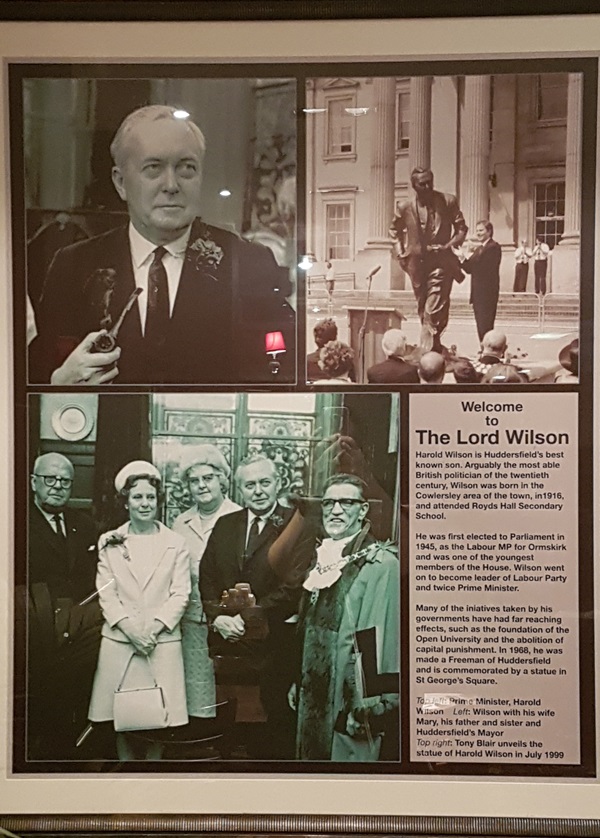
The text reads: Harold Wilson is Huddersfield’s best known son. Arguably the most able British politician of the twentieth century, Wilson was born in Cowlersley area of the town, in 1916, and attended Royds Hall Secondary School.
He was first elected to Parliament in 1945, as the Labour MP for Ormskirk and was one of the youngest members of the House. Wilson went on to become leader of Labour Party and twice Prime Minister.
Many of the initiatives taken by his governments have had far reaching effects, such as the foundation of the Open University and the abolition of capital punishment. In 1968, he was made a Freeman of Huddersfield and is commemorated by a statue in St George’s Square.
Top left: Prime Minister, Harold Wilson
Left: Wilson with his wife Mary, his father and sister and Huddersfield’s Mayor
Top right: Tony Blair unveils the statue of Harold Wilson in July 1999.
Photographs and text about Roy Castle.
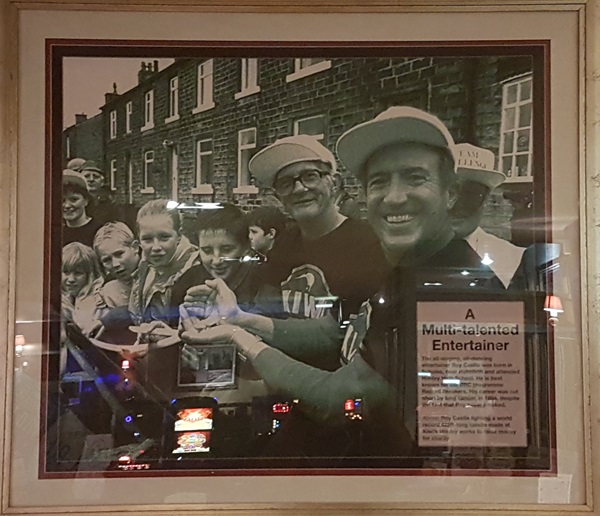
The text reads: The all-singing, all-dancing entertainer Roy Castle was born in Scholes, near Holmfirth and attended Honley High School. He is best known for the BBC programme Record Breakers. His career was cut short by lung cancer, in 1994, despite the fact that Roy never smoked.
Above: Roy Castle lighting a world record 422ft-long candle made at Kiwi’s Honley works to raise money for charity.
Photographs and text about Castle Hill.
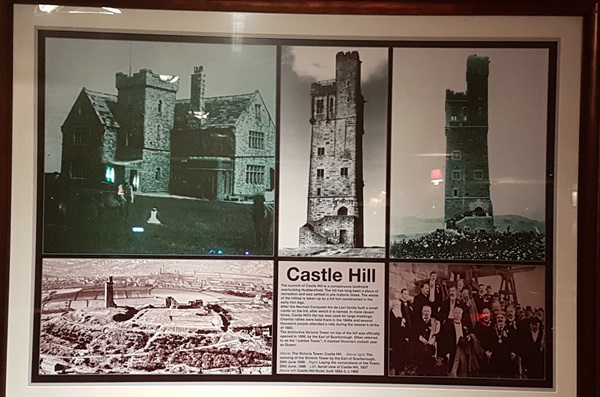
The text reads: The summit of Castle Hill is a conspicuous landmark overlooking Huddersfield. The hill has long been a place of recreation and was settled in pre-historic times. The whole of the hilltop is taken up by a hill fort constructed in the early Iron Age.
After the Norman Conquest the de Laci family built a small castle on the hill, after which it is named. In more recent times, Castle Hill’s flat top was used for large meetings. Chartist rallies were held there in the 1840s and several thousand people attended a rally during the weaver’s strike of 1883.
The distinctive Victoria Tower on top of the hill was officially opened in 1899, by the Earl of Scarborough. Often referred to as the Jubilee Tower, it marked Victoria’s sixtieth year as Queen.
Above: The Victoria Tower, Castle Hill
Above right: The opening of the Victoria Tower by the Earl of Scarborough, 24 June 1899
Right: Laying the cornerstone of the Tower, 25 June, 1898
Left: Aerial view of Castle Hill, 1937
Above left: Castle Hill Hotel, built 1852-3, c1900.
Photographs and text about James Mason.
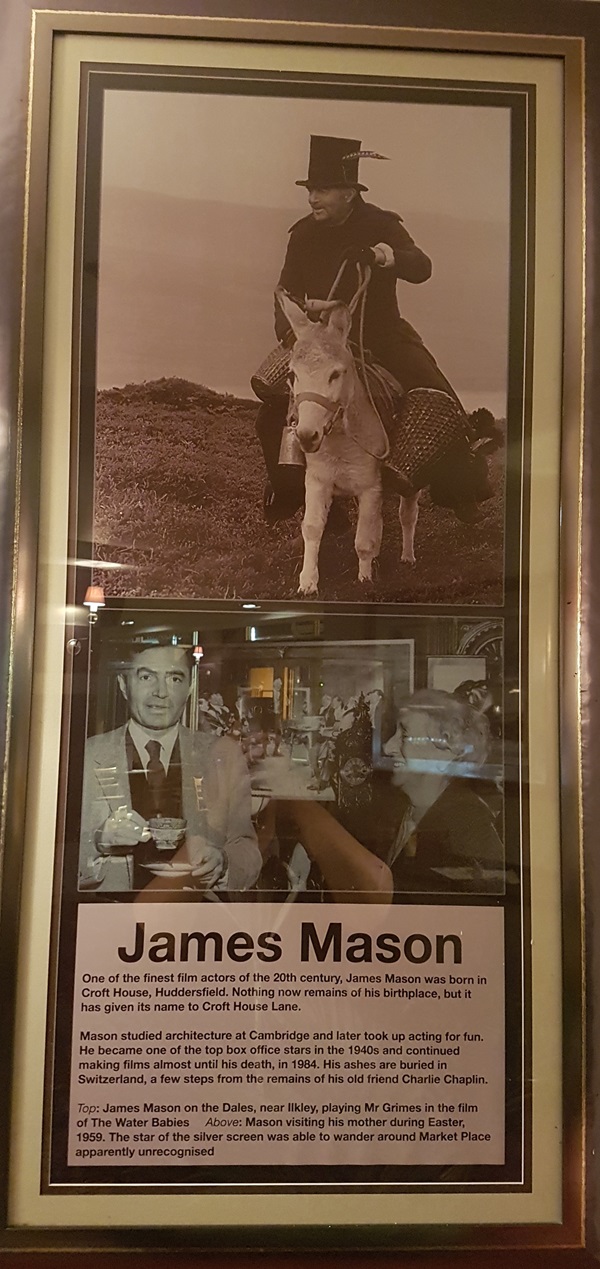
The text reads: One of the finest film actors of the 20th century, James Mason was born in Croft House, Huddersfield. Nothing now remains of his birthplace, but it has given its name to Croft House Lane.
Mason studied architecture at Cambridge and later took up acting for fun. He became one of the top box office stars in the 1940s and continued making films almost until his death, in 1984. His ashes are buried in Switzerland, a few steps from the remains of his old friend Charlie Chaplin.
Top: James Mason on the Dales, near Ilkley, playing Mr Grimes in the film of The Water Babies
Above: Mason visiting his mother during Easter, 1959. The star of the silver screen was able to wander around Market Place apparently unrecognised.
Photographs of Huddersfield.
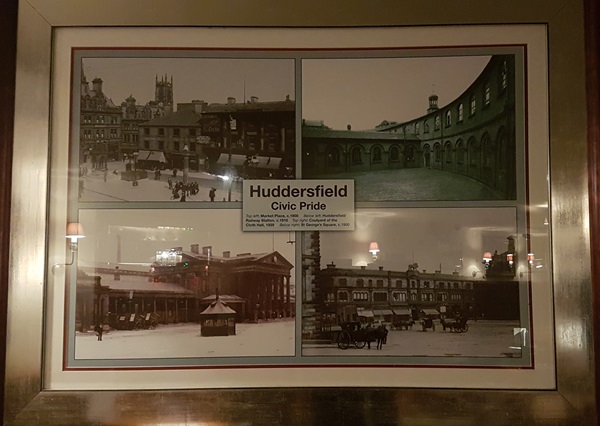
Top left: Market Place, c1900
Below left: Huddersfield Railway Station, c1910
Top right: Courtyard of the Cloth Hall, 1929
Below right: St George’s Square, c1900.
Prints and text about The Cherry Tree.
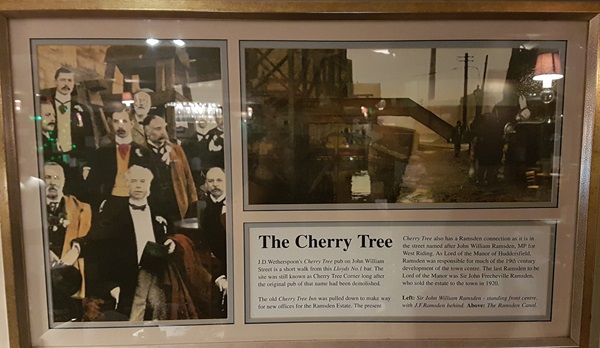
The text reads: J D Wetherspoon’s Cherry Tree pub on John William Street is a short walk from this Lloyds No. 1 bar. The site was still known as Cherry Tree Corner long after the original pub of that name had been demolished.
The old Cherry Tree Inn was pulled down to make way for new offices for the Ramsden Estate. The present Cherry Tree also has a Ramsden connection as it is in the street named after John William Ramsden, MP for West Riding. As Lord of the Manor of Huddersfield, Ramsden was responsible for much of the 19th century development of the town centre. The last Ramsden to be Lord of the Manor was Sir John Frecheville Ramsden, who sold the estate to the town in 1920.
Left: Sir John William Ramsden – standing front centre, with JF Ramsden behind
Above: The Ramsden Canal.
Prints and text about Zetland Street.
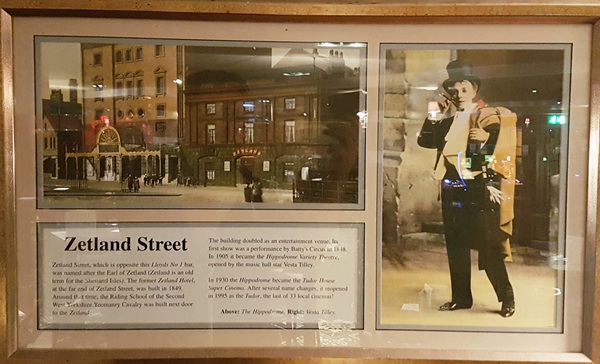
The text reads: Zetland Street, which is opposite this Lloyds No 1 bar, was named after the Earl of Zetland (Zetland is an old term for the Shetland Isles) The former Zetland Hotel, at the far end of Zetland Street, was built in 1849. Around that time, the Riding School of the Second West Yorkshire Yeomanry Cavalry was built next door to the Zetland.
The building doubled as an entertainment venue. Its first show was a performance by Batty’s Circus in 1848. In 1905 it became the Hippodrome Variety Theatre, opened by the music hall star Vesta Tilley.
In 1930 the Hippodrome became the Tudor House Super Cinema. After several name changes, it reopened in 1995 as the Tudor, the last of 33 local cinemas!
Above: The Hippodrome
Right: Vesta Tilley.
A photograph and text about Anita Lonsbrough.
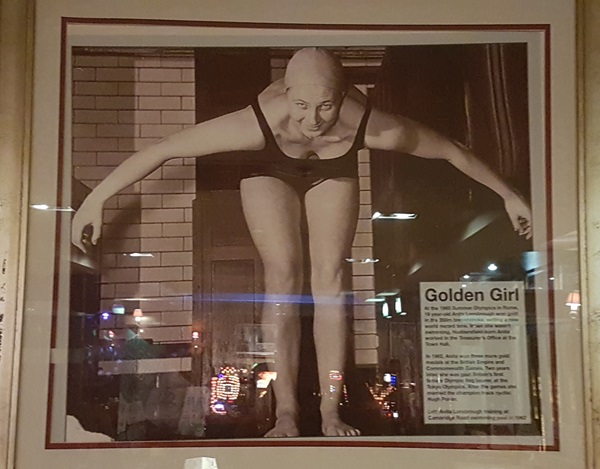
The text reads: At the 1960 Summer Olympics in Rome, 19 year-old Anita Lonsbrough won gold in the 200m breaststroke, setting a new world record time. When she wasn’t swimming, Huddersfield-born Anita worked in the Treasurer’s Office at the Town Hall.
In 1962, Anita won three more gold medals at the British Empire and Commonwealth Games. Two years later, she was great Britain’s first female Olympic flag bearer, at the Tokyo Olympics. After the games she married the champion track cyclist Hugh Porter.
Left: Anita Lonsbrough training at Cambridge Road swimming pool in 1962.
External photograph of the building – main entrance.
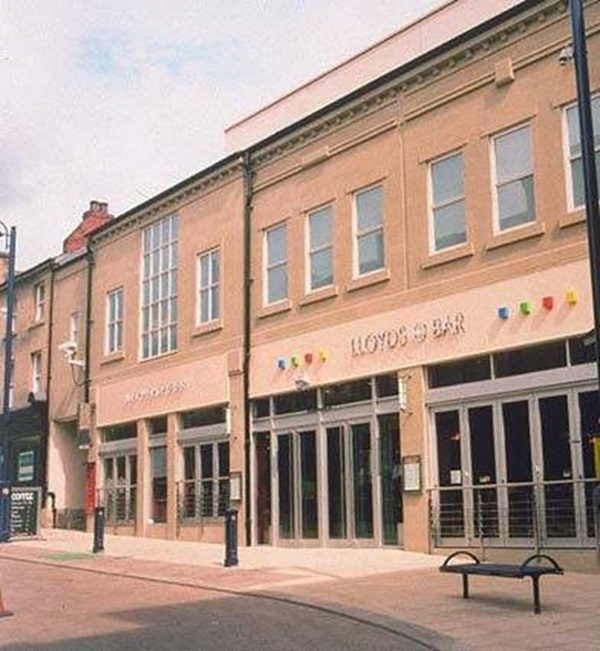
If you have information on the history of this pub, then we’d like you to share it with us. Please e-mail all information to: pubhistories@jdwetherspoon.co.uk